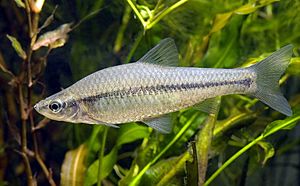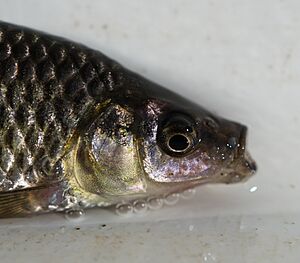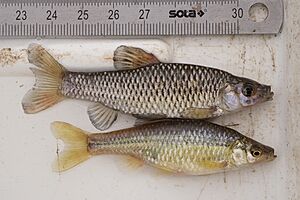Stone moroko facts for kids
The stone moroko (Pseudorasbora parva), also known as the topmouth gudgeon, is a small fish. It belongs to the carp and minnow family. This fish is originally from Asia. However, it has been introduced to Europe and North America, where it is now considered an invasive species.
Quick facts for kids Stone moroko |
|
|---|---|
 |
|
| Conservation status | |
| Scientific classification | |
| Synonyms | |
|
Most stone moroko fish are between 2 and 7.5 cm long. They rarely grow bigger than 8 cm.
Contents
What is an Invasive Species?
An invasive species is an animal or plant that is brought to a new place. It then spreads quickly and harms the local environment. The stone moroko is a good example of this.
Stone Moroko in Europe
Since 2016, the stone moroko has been on the European Union's list of "Invasive Alien Species of Union concern." This means it is against the law to bring this fish into the European Union. You also cannot breed it, move it around, sell it, or let it go into the wild.
The fish first arrived in Europe in the 1960s. It was introduced into ponds in Nucet, Dâmbovița County, Romania. From there, it got into the Danube River. This allowed it to spread all across Europe.
These fish cause problems because they eat the eggs of local fish species. These local fish are important for the environment and for fishing.
Scientists have found that the stone moroko fish that spread into Europe came from different areas in Asia. These areas include the Yangtze River basin in China and parts of the Amur River basin in Russia and China.
Stone Moroko in the UK
Recently, the stone moroko has also been found in some lakes in the United Kingdom. People believe these fish were put there illegally. Because of this, the Environment Agency has started a big program to get rid of them. They use a special chemical called rotenone to remove the fish from the water.
Stone Moroko and Parasites
The stone moroko can be dangerous to other fish, like the sunbleak (Leucaspius delineatus). This is because the stone moroko can carry a tiny living thing called a protist (Sphaerothecum destruens). This protist does not harm the stone moroko itself. However, it attacks other fish like the sunbleaks. When infected, sunbleaks cannot lay eggs properly and are more likely to die.
A study in 2023 showed that the stone moroko brought three new types of tiny worms, called monogenean parasites, with it from East Asia to Europe. These parasites are named Dactylogyrus squameus, Bivaginogyrus obscurus, and Gyrodactylus pseudorasborae. The stone moroko also got infected with a local monogenean parasite called Gyrodactylus prostae.
Interestingly, the stone moroko often had fewer of these parasites than local fish. This might give the stone moroko an advantage, helping it to spread more easily in new places.




